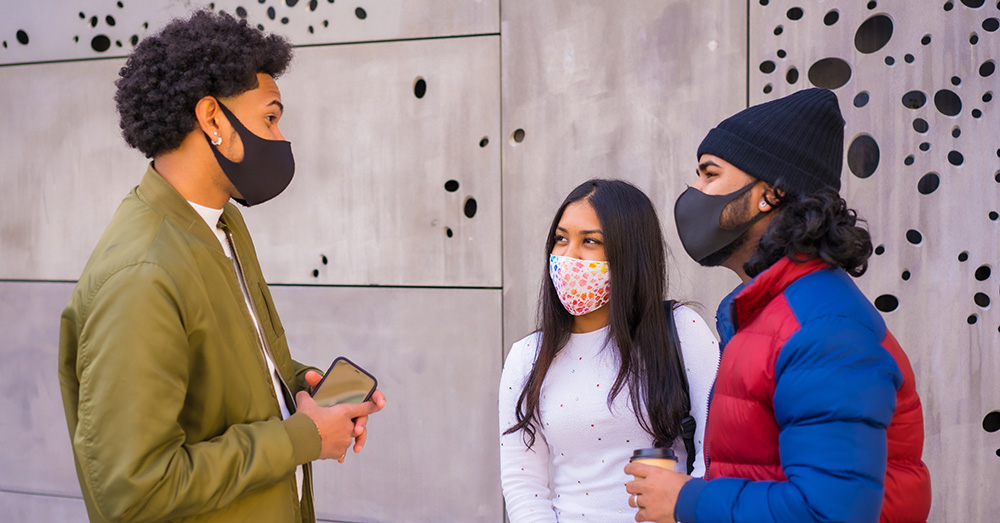How Facemasks Affect Communication
With a few simple tips, we can all be better communicators while wearing face coverings.

The COVID-19 pandemic has had a profound impact on all of our lives, some more tragically than others. As a nation, we went from resisting the necessity of face coverings to not leaving the house without them. While the increased mask wearing has helped fight the spread of COVID-19, it has also severely affected interpersonal communication.
We spoke with Hoyoung Yi, Ph.D, CCC-SLP, Assistant Professor in the Center for Speech, Language, and Hearing Research department of the TTUHSC School of Health Professions.
Yi also operates the TTUHSC Speech Production Lab, designed to gather information and data to provide better services for young children with speech and language delay and their families, as well as adult clients and families.
Yi discussed how facemasks hinder communication, and she shared strategies to overcome the obstacle.
What Did You Say?
Yi points out that researchers have not only been evaluating the effects of masking on communication, but also examining various types of masks to see how much they reduce acoustic signals.
“Since 2019, many researchers have evaluated acoustic signals through all types of facemasks,” she says. The surgical masks most commonly used have been shown to dampen decibels. Transparent masks increase communication signals more than others. Yi also notes that background noise plays a large role in one’s ability to hear and understand what is being said.
Are You Smiling at Me Under Your Mask?
Visual information is decreased by face coverings, which also affects our ability to communicate.
“It’s hard to identify emotion and facial expressions behind a mask,” Yi says.
Again, clear masks allow for better communication, especially with background noise present. However, Yi says that when speaking with someone that you can’t see, like on the phone, it is better to use a surgical mask. In a phone-call situation, it’s not recommended to use a transparent mask because we can’t see each other’s faces, and there’s no benefit to using it.
Clear Speech and Gestures While Wearing Facemasks

Th Clear speech is simply a way of speaking in which every word, sentence and idea is spoken extremely clearly and simply to ensure understanding. Yi compares it to how one would speak with a person who was hard of hearing.
Mask wearing has encouraged us to speak more clearly, with clear speech, to compensate for the inability to see mouths and lips.
“Clear speech can spontaneously elicit speech intelligibility,” she says. “My studies have shown no difference between no mask and a surgical mask when speaking clearly, if we are not face to face. Speech intelligibility is not reduced with a surgical mask when a talker speaks clearly even though there is background noise. We see no difference between no mask and a transparent mask when we speak clearly during face-to-face conversations in the presence of background noise.”
Using more gestures can also increase speech communication, according to Yi. It’s important not to limit gestures to your hands and arms. Our faces make expressive gestures, as well.
“Some talkers, when they use clear speech, I can see more movement of eyebrows compared to other kinds of speech,” she says. “That helps to identify grammar boundaries, beginnings and endings of sentences.”
An example is someone who uses his or her eyebrows well to clearly read sentences for a recording. Even without seeing their face, the exaggerated use of eyebrows helps them be more understandable.
“Several studies show that visual information is critical for communication,” Yi continues. “More than 50 percent of what we understand from others is in the form of gestures or facial expressions.”
She also recommends helping your listener identify the boundaries between words - the beginnings and endings of sentences - which helps with emphasis and understanding.
“Identifying the boundaries between words can be easier if a talker uses clear speech,” she reinforces. “Because the talker in my study used eyebrow movements while speaking clearly, that helped listeners with identifying a beginning point of a word.”
Why Do We Experience Difficulty Understanding Each Other Over a Face Mask?
Visual Feedback
“Visual information plays a prominent role in communication,” Yi says. “To recognize others’ emotions, we need to see their faces.” Emotions such as smiling or happiness are recognized from the lower part of the face, hidden by the mask.
Yi says that masking leads to the McGurk effect, which occurs when there is a conflict between visual and auditory speech. Visual speech is the movement of the mouth and lips and auditory speech is the sounds the speaker makes. This conflict of signals can result in miscommunication and the perception of an entirely different message than intended.
Reduced Acoustic Signals
There have been many recent studies revealing the acoustic attenuation, or weakening of sound waves, from various types of masks. “Simple surgical masks that we often use appear to reduce sounds the least, while transparent masks and face shields seem to attenuate sounds the most.”
Speech intelligibility was shown to decrease with various types of face masks, especially
in the presence of background noise.
Environmental Factors - Background Noise
The combination of background noise and required facial coverings can increase the
difficulty for people to communicate effectively and efficiently.
“We often encounter noisy environments such as coffee shops or reception areas when
we have face-to-face communication,” Yi says. “Listeners rely extensively on seeing
talkers’ articulatory movements and facial expressions to understand spoken words
in noisy environments.”
What Are Potential Solutions to Communication Difficulties With Face Masks?
Transparent Masks
Even though transparent masks cause a greater decrease in acoustic signals than other face masks, they are recommended because of the visual communication they enable. “According to my research outcomes, transparent masks enhanced speech intelligibility by providing visual access, especially the lip and jaw articulatory movements,” Yi says.
The CDC also recommends using a transparent mask for:
- People with hearing loss
- Young children or students learning to read
- Students learning a new language
- People with disabilities
Clear Speech, Background Noise, & Communicating Your Feelings
Yi recommends using clear speech by slowing down and increasing your volume according to the safety and privacy of your location. Exaggerating your prosody, or attitude and intention, will also aid understanding.
The minimal acoustic attenuation from a surgical mask can be compensated with the use of clear speech. Clear speech can also overcome the substantial amount of acoustic reduction from a transparent mask, as long as there is clear visual information available.
Finding quiet places will minimize the background noise, which often interferes with communication, requiring visual communication.
Finally, become accustomed to verbally expressing your emotions. So much of our emotions are expressed through facial expressions. Simply saying “I am smiling at you” will help create more fully understandable communication.
Related Stories
Making Mental Health a Priority in the New Year
Sarah Mallard Wakefield, M.D., a psychiatrist with Texas Tech Physicians, talks about strategies to combat widespread and growing anxiety.
TTUHSC Dean to be Inducted into the National Academies of Practice as Distinguished Fellow
Gerard E. Carrino, Ph.D., MPH, dean of the TTUHSC Julia Jones Matthews School of Population and Public Health, will be inducted into the National Academies of Practice (NAP) as a Distinguished Fellow of the Public Health Academy.
TTUHSC School of Nursing Celebrates 10-Year Anniversary of the Abilene Community Health Center
The TTUHSC School of Nursing hosted a 10-Year Anniversary Celebration and Open House for the Abilene Community Health Center. The center is one of 71 Federally Qualified Health Centers (FQHCs) in Texas according to the Texas Health and Human Services.
Recent Stories
Making Mental Health a Priority in the New Year
Sarah Mallard Wakefield, M.D., a psychiatrist with Texas Tech Physicians, talks about strategies to combat widespread and growing anxiety.
TTUHSC Cancer Researcher Honored by National Academy of Inventors
C. Patrick Reynolds, M.D., Ph.D., director of the School of Medicine Pediatric Cancer Research Center at TTUHSC, has dedicated his life as a researcher to developing treatments for childhood cancers.
TTUHSC School of Nursing Celebrates 10 Years of the Veteran to BSN Program
The TTUHSC School of Nursing recognized the 10-year anniversary of the Veteran to Bachelor of Science in Nursing (VBSN) program during the fall 2025 commencement ceremonies held Dec. 13 in Lubbock, Texas.
